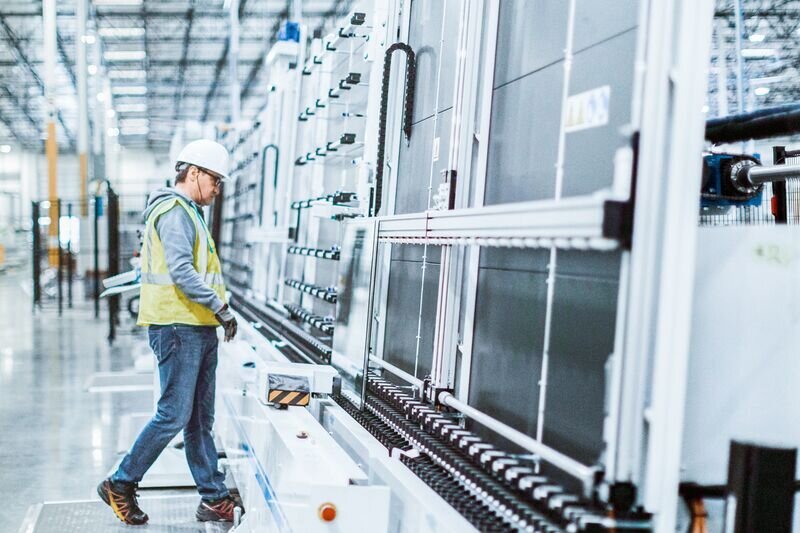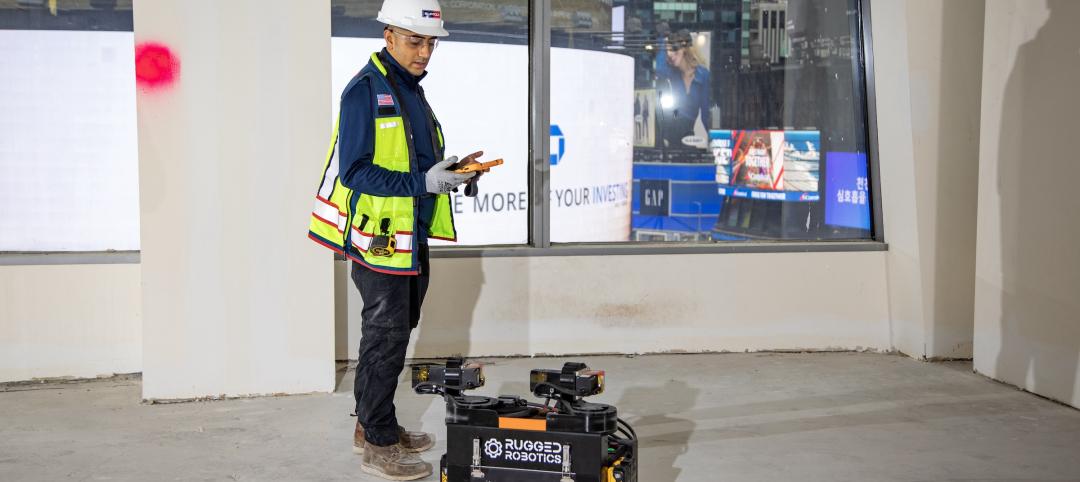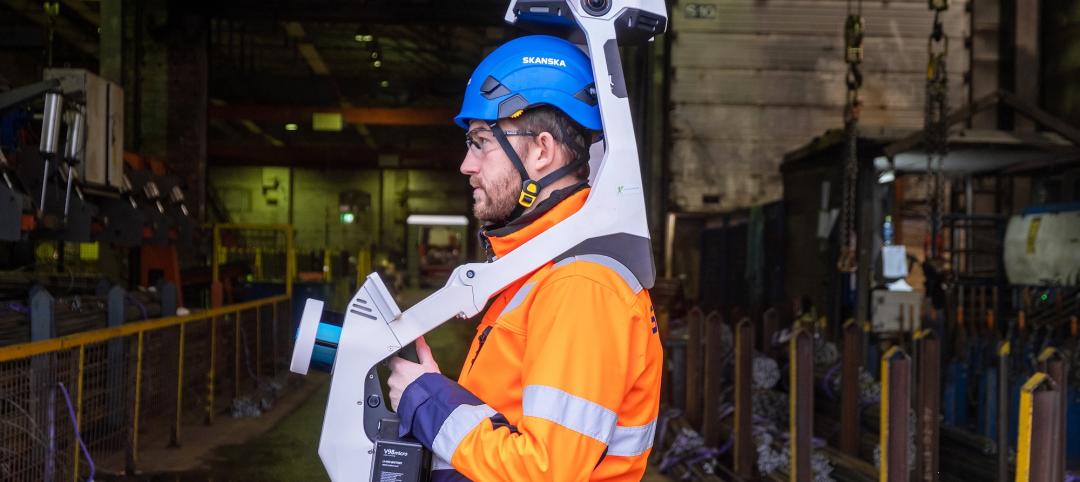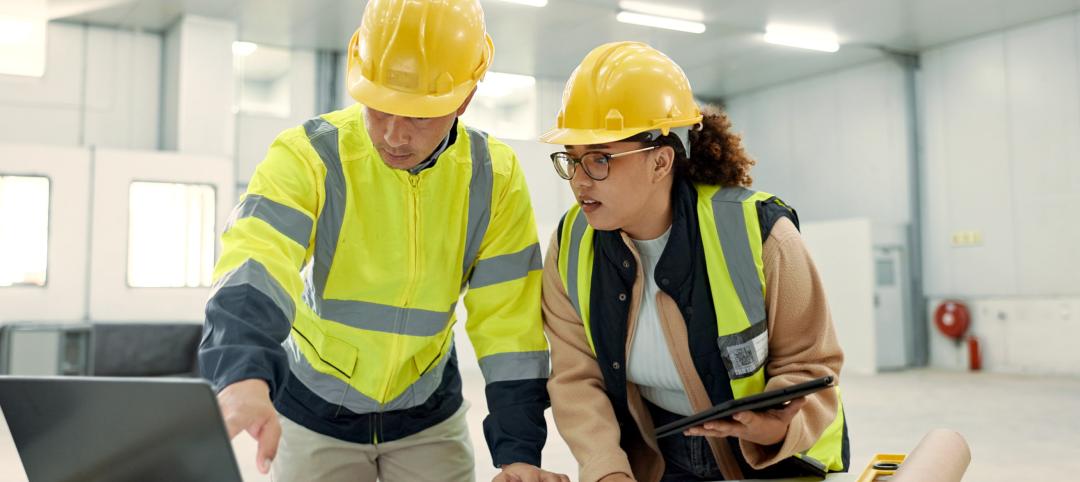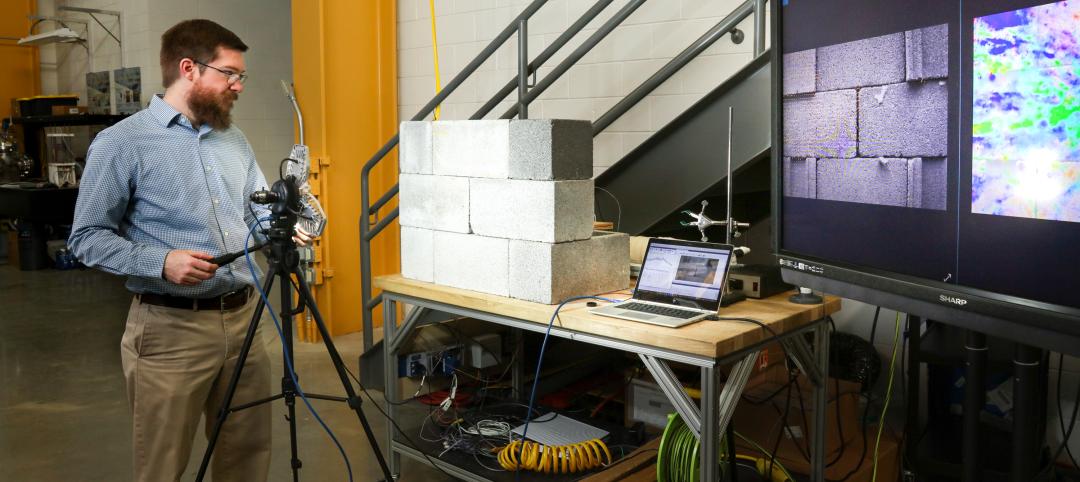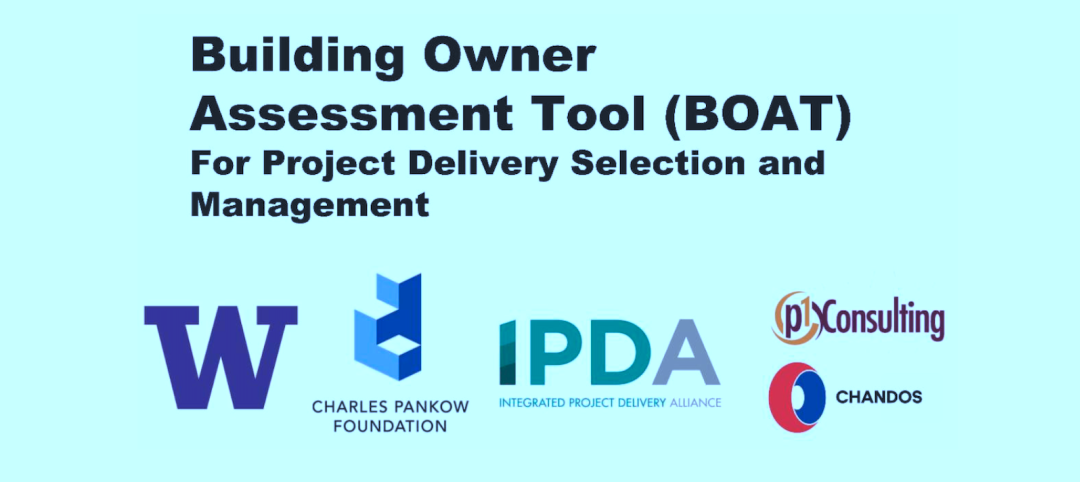The novel coronavirus pandemic has reshaped the construction industry, mostly positively in terms of operational efficiency and worker safety. It has also accelerated the growth—and funding for—construction technology, while creating a hierarchy for how broadly the industry has adopted these tools.
In its latest “State of Construction tech” report, released today, JLL aims to organize the wide range of technology options and measure how the pandemic has impacted their application by AEC firms and the clients on their projects.
Henry D’Esposito, JLL’s Construction Research Senior Analyst and the report’s author, asserts that, due to the pandemic, “three years of construction technology growth and adoption have been compressed into the past nine months.” Venture capital has continued to flow to startups, with funding levels about on par with the average for the past five years.
Construction tech kept jobsites open and projects running. It also allowed AEC firms whose employees were forced to work remotely to maintain their workflows. According to a recent U.S. Chamber of Commerce survey, 67% of the construction firms polled allowed employees to work from home. However, JLL notes that smaller firms were less likely to have systems in place.
Construction firms in general with fewer discretionary dollars were likelier to select proven tech solutions rather than take a risk on a less-mature startup.
WEARABLES IMPROVE WORKER SAFETY
ConTech enabled onsite execution in two ways, JLL observes: First, by creating opportunities to have fewer people on a jobsite. Second, by keeping anyone who is essential to being onsite as safe as possible.
“Technology solutions that have expanded this year include wearables and monitoring devices to ensure workers stay socially distanced and to allow contact tracing if any issues arise; and planning tools to enable optimal efficiency in staging and scheduling to ensure that teams stay separated,” says JLL.
Wearables were among the ConTech tools for which the impact of the pandemic on their usage was deemed “high” by JLL.
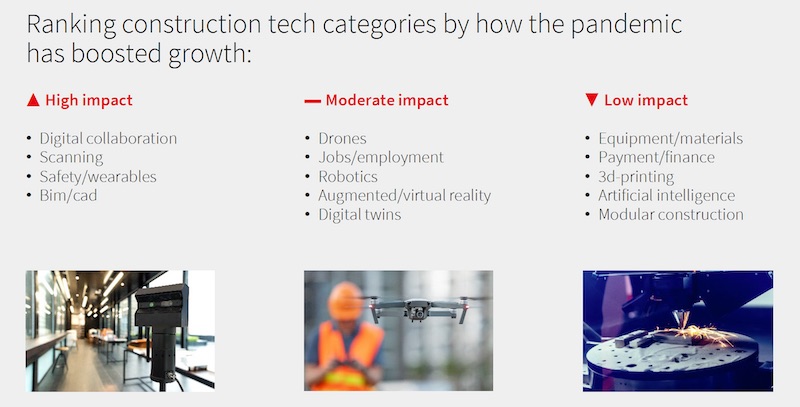
JLL has organized ConTech by its relative impact on construction, and whether the coronavirus affected that impact. Image: JLL
The report identifies the ConTech hierarchy into three groups:
•Foundational technologies that have become standard fare for AEC firms. These include BIM and CAD, digital twins, Artificial Intelligence (AI), and digital collaboration;
•Primary impact technologies that are gaining acceptance, such as scanning, drones, and modular construction; and
•Secondary impact technologies that are still in their early stages of adoption. Wearables falls into this category, as do 3D printing, robotics, AR/VR, and tools related to payments/finance, equipment/materials, and jobs/employment.
JLL believes that BIM and CAD, scanning, and digital collaboration each got a “pandemic boost,” whereas AI may have lost some steam. Scanning, for example, gained importance during the health crisis “as a way to replace additional eyes onsite, and as a substitute for in-person meetings and walkthroughs.” Prior to the pandemic, scanning was a more efficient and comprehensive way to collect data. But under regulations where a limited number of staff can be onsite at any time, “interior scanning has often become a necessity to ensure that all members of a project teams are on the same page, even if they cannot be onsite.”
ROBOTS AND 3D PRINTERS STILL HAVE A WAYS TO GO FOR INDUSTRY ACCEPTANCE
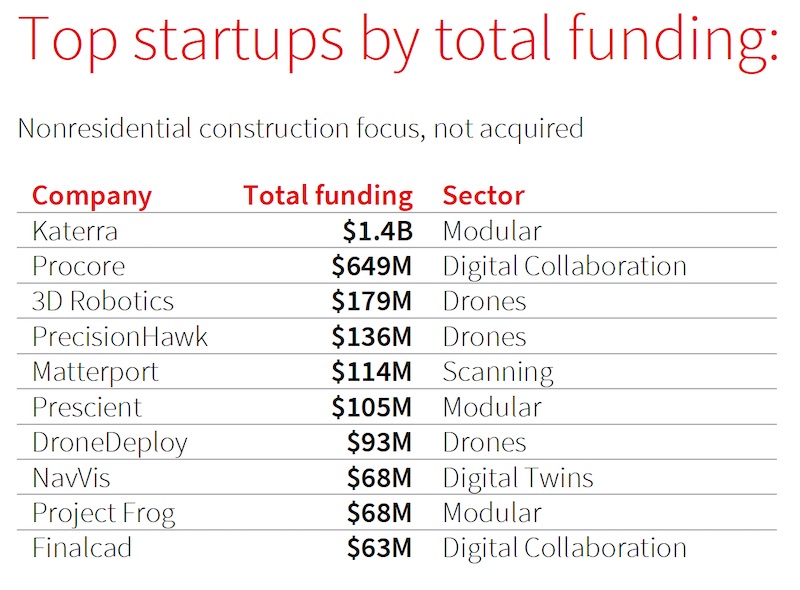
Venture capital funding for ConTech during 2020 was in line with levels over the past five years. Image: JLL
Drones, says JLL, got a moderate boost from the pandemic because “of their ability to do the work of multiple people, and to do so in a way that keeps people socially distanced.”
And while many AEC firms claim to be embracing modular construction for quicker project delivery, JLL finds that the impact of the pandemic hasn’t been much of a factor on leading more firms to this method. “On the positive side, modular manufacturing can be done in a controlled factory setting, with the ability for extensive preplanning to maintain social distancing without the unknowns of an active jobsite. On the negative side, modular construction remains an economically high-risk endeavor.”
The pandemic also has had mixed impact on other ConTech tools. Its effect on the adoption of 3D printing, for example, was low, says JLL, which predicts that the future of 3D printing is brighter for single-family home construction or certain military applications than for nonresidential construction.
JLL is a bit more sanguine about robotics, which got a moderate boost from the pandemic. “With the addition of AI, this sector is developing for more advanced tasks, including fully automated excavation or interior chalk lining.” Nevertheless, JLL expects robots to be used on a limited basis for pilot projects for at least the next few years.
Augmented and virtual reality are still in their early development stages, and both have the potential to become standard on construction projects. But, JLL cautions, “they will only work on projects with high adoption of other forms of tech that would be required for integration.”
Related Stories
AEC Tech | Mar 9, 2024
9 steps for implementing digital transformation in your AEC business
Regardless of a businesses size and type, digital solutions like workflow automation software, AI-based analytics, and integrations can significantly enhance efficiency, productivity, and competitiveness.
AEC Tech | Feb 28, 2024
How to harness LIDAR and BIM technology for precise building data, equipment needs
By following the Scan to Point Cloud + Point Cloud to BIM process, organizations can leverage the power of LIDAR and BIM technology at the same time. This optimizes the documentation of existing building conditions, functions, and equipment needs as a current condition and as a starting point for future physical plant expansion projects.
AEC Innovators | Feb 28, 2024
How Suffolk Construction identifies ConTech and PropTech startups for investment, adoption
Contractor giant Suffolk Construction has invested in 27 ConTech and PropTech companies since 2019 through its Suffolk Technologies venture capital firm. Parker Mundt, Suffolk Technologies’ Vice President–Platforms, recently spoke with Building Design+Construction about his company’s investment strategy.
AEC Tech | Feb 20, 2024
AI for construction: What kind of tool can artificial intelligence become for AEC teams?
Avoiding the hype and gathering good data are half the battle toward making artificial intelligence tools useful for performing design, operational, and jobsite tasks.
AEC Tech | Feb 20, 2024
ABC releases technology guide for AI in construction
Associated Builders and Contractors has released an artificial intelligence (AI) technology guide for the U.S. construction industry. AI in Construction — What Does It Mean for Our Contractors? outlines definitions, construction use cases, and considerations for the implementation of AI in construction.
AEC Tech | Jan 24, 2024
4 ways AEC firms can benefit from digital transformation
While going digital might seem like a playground solely for industry giants, the truth is that any company can benefit from the power of technology.
Modular Building | Jan 19, 2024
Building with shipping containers not as eco-friendly as it seems
With millions of shipping containers lying empty at ports around the world, it may seem like repurposing them to construct buildings would be a clear environmental winner. The reality of building with shipping containers is complicated, though, and in many cases isn’t a net-positive for the environment, critics charge, according to a report by NPR's Chloe Veltman.
AEC Tech | Jan 8, 2024
What's driving the surge of digital transformation in AEC today?
For centuries, the AEC industry has clung to traditional methods and legacy processes—seated patterns that have bred resistance to change. This has made the adoption of new technologies a slow and hesitant process.
Sustainability | Nov 1, 2023
Researchers create building air leakage detection system using a camera in real time
Researchers at the U.S. Department of Energy’s Oak Ridge National Laboratory have developed a system that uses a camera to detect air leakage from buildings in real time.
Building Owners | Aug 23, 2023
Charles Pankow Foundation releases free project delivery selection tool for building owners, developers, and project teams
Building owners and project teams can use the new Building Owner Assessment Tool (BOAT) to better understand how an owner's decision-making profile impacts outcomes for different project delivery methods.


